Macbook + Fanta = Yatran / Moscow?
To write an article on this topic I was inspired by the not quite pleasant case that happened to me the other day ... My laptop became a victim of sweet water called Fanta. If you just drop a glass of forfeits on the sidewalk, the cost of the loss will be no more than six rubles, but if you shed it on the keyboard of a Mac laptop, the issue price will increase to two thousand dollars.

“It would be better if I washed the whole street with a fanto, it’s cheaper,” I complained to a friend who, without hesitation, advised while Mas was in repair, to work on Yatran'ka, it will be a bit heavy! What is Yatranka, I learned, using the Google search engine) - it turned out to be a typewriter.
')
At the same time, he told his “regrettable” story from his childhood from the Yatran typewriter.
Sometime something similar happened to me. Having finished my lessons, I decided to write a letter to my beloved grandfather, so much to surprise. There was no computer then, but the space under the table was not empty, the Yatran electric typewriter was stored there. While papa, straining all the muscles of his arms and back, was tearing her off the floor, as if it was not a machine, but a ship that sank under the table, I went to the kitchen to get Pepsi. "The younger generation chooses Pepsi," said the slogan of the late nineties. Feeling inspired and taking a bottle with me, I sat down at my desk. The engine was buzzing, the carriage was running, and thoughts were cheerfully minted on paper. But the trouble! Inadvertently knocked over the bottle, sweet dark drops and splashed inside - richly "moistened" the bosom of the iron body. I automatically pulled the plug out of the net. What now? But after five minutes the fear receded and I decided to turn it on again. Contrary to expectations, no spark, no short circuit followed. On the contrary! After printing a couple of lines, I clearly felt that the device began to work faster and better, as if it was not pepsi-cola, but oil, which lubricated the rubbing dry mechanism in time. Five minutes later, the letter was ready, and the machine sank again, in the legs, half a meter below the "sea level" of the table.
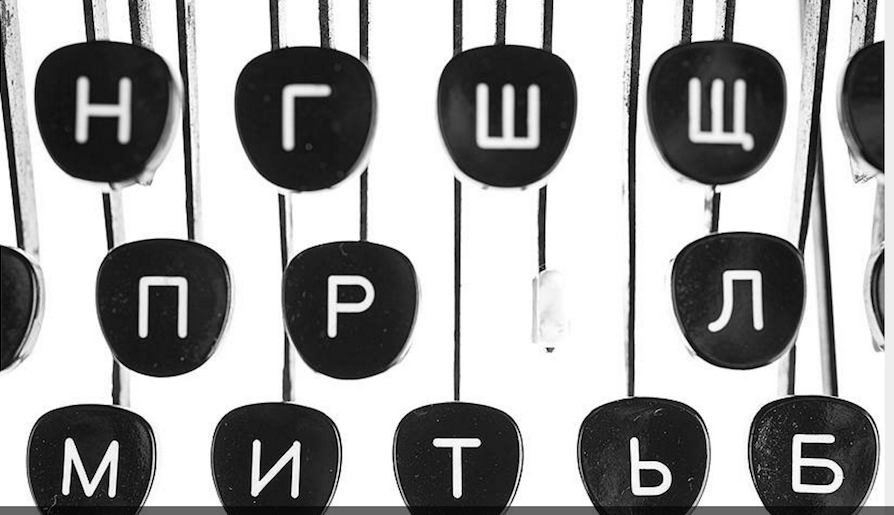
About the Yatran typewriter a little later, because it became interesting to learn in more detail about what preceded the usual typing on a computer keyboard. If earlier a typewriter was a means of typing characters, expressing and replicating thoughts, then a computer is already a device for integrating a person into the world information space. Everyone knows that the keyboard layout and the principle of its operation is that small gene pool that the modern “electronic friend of a man” inherited from a typewriter. But which of our parents could believe that having only the keys with letters on you can call yourself a taxi, order goods at home or publish an article on the Internet? Today, the reality is that life without pressing soft keys, or without driving your finger on the sensor, is not only impossible, but sometimes dangerous to health. In 2009, an interesting material was published in a Finnish newspaper, tips on picking mushrooms for beginning scouts. Lovers of protein of plant origin, in all seriousness recommended to take a laptop into the forest and check their mushrooms with pictures on a special site. Can you imagine a mushroom picker with a laptop and a basket of chanterelles?
Just a couple of decades ago, no institution, organization, office could not do without such, at the moment, rare miracle of technology like a typewriter. Immediately I recall at least a couple of Soviet films, in the frame of which typewriters of one brand or another made up on the table. By the way - a prestigious thing, which over the years has replaced the keyboard and monitor (well, and a couple of programs like Word).
Since childhood (aunt worked as a secretary in the village council) I remember these knocking sounds, a short ringing made by the machine during the return movement of the carriage. Oh, and if you also managed to “work” with such a technique, write a couple of letters not by hand - there were enough impressions for a few days.
Typing the text now (here now this article) doesn’t cause any special problems, since you can easily remove / replace the letter word, and there is a whole text, you just need to press the desired key. On the other hand, it was with typewriters, the letter bladed for help (whitewashed a little later) was not correctly knocked out, and this was at best, and you just had to take a sheet of paper and throw it away, and the work started anew. The wise decision was to initially write the text by hand with a pen, and then type it on a typewriter.
The year 1873 is considered the beginning of the production of the first typewriters, although the idea of its creation arose a couple of centuries earlier. In England, even issued a royal order, in which there was a decree to create a device for printing texts, in 1714 Queen Anne granted a patent to Henry Mill for such a “thing”. Since there is no information about this device, the first operating machine that was presented to the world by an Italian named Terry Pellegrino was a writing apparatus made for the blind girlfriend of Countess Caroline Fantoni de Fivizono in 1808. Due to this, she was able to communicate with her friends and relatives through correspondence.

In 1886, George Anderson patented a tape for a typewriter. It remains an interesting fact that the mechanism for typing was invented 52 times: such models were reminiscent of a wedding cake, and a gaming machine, one model was 2.5 meters high. The keyboard for such typewriters, similar to a piano one, appeared only in the 30s of the XIX century. Letters on such a keyboard with the help of rollers were covered with ink. Charles Turber patented a typewriter for the blind in the distant 1843, and he also invented a lever transmission of the movement of letters.
Create an ideal and convenient apparatus for writing - this is what captures the minds of the inventors of the time. The Americans Christopher Scholes and Samuel Sule in 1863 invented a device for numbering pages in counting books, and this principle was laid when creating a typewriter. The first such patented machine had two rows of keys with numbers and alphabetical arrangement of letters from A to Z, the letters were capitalized and there were no numbers 1 and 0, they were replaced by the letters “I” and “O”. It was difficult to call such a device convenient, because with a quick successive pressing of the letters located nearby, the hammers with the letters got stuck, the work was suspended and it was necessary to rake the jam by hand. After analyzing the most common letters in the English alphabet, they were located on the keyboard as far as possible from each other, which made it possible to avoid such “sticking”. So the QWERTY keyboard was invented.

early typewriter type
For five years, the inventors improved their patented Type-Writer and signed an agreement to release 10,000 typewriters with Remington and Sons
The first serial typewriter was the Remington No. 1 typewriter, which saw the world on July 1 in 1874.

Remington # 1
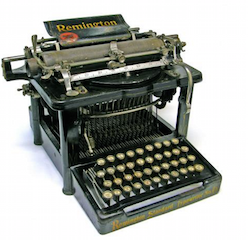
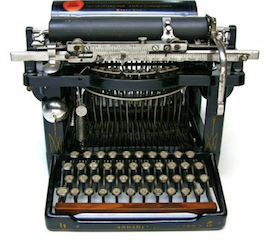
later models Remington # 5 and 6
It even produced furniture for such a typewriter:
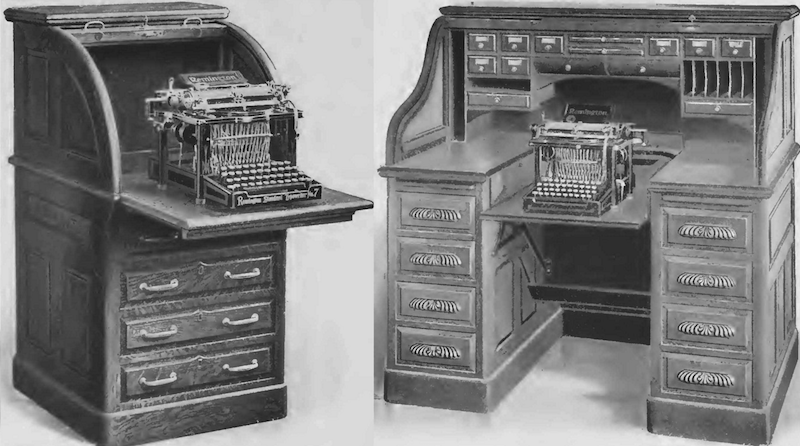
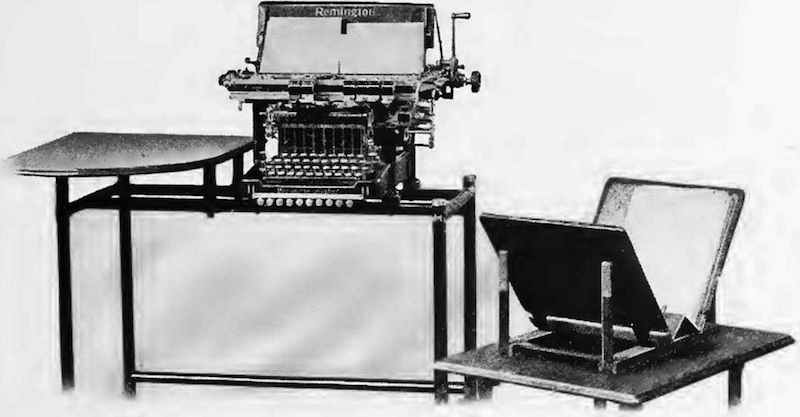
What typewriters were not created. Each such typewriter resembled a real masterpiece.
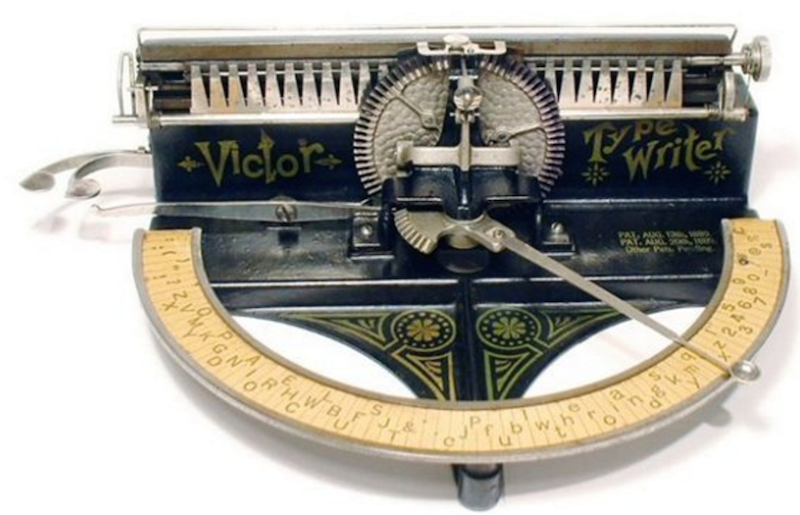
Special purpose printing presses were developed and produced: verbatim, bookkeeping, writing formulas, for the blind and many others.

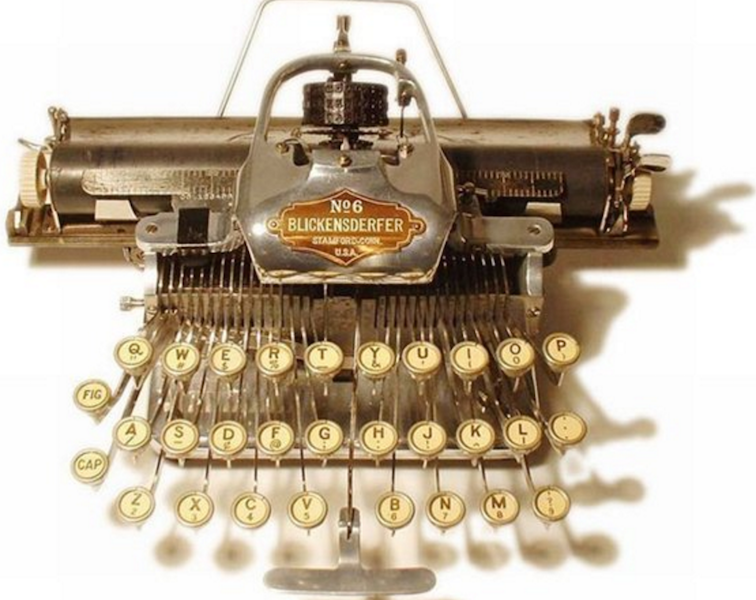
Typewriters without a keyboard, so-called index typewriters, were developed. Such machines cost less, a letter on the index was selected with one hand, and a lever for printing a letter on paper was pressed with the other hand.
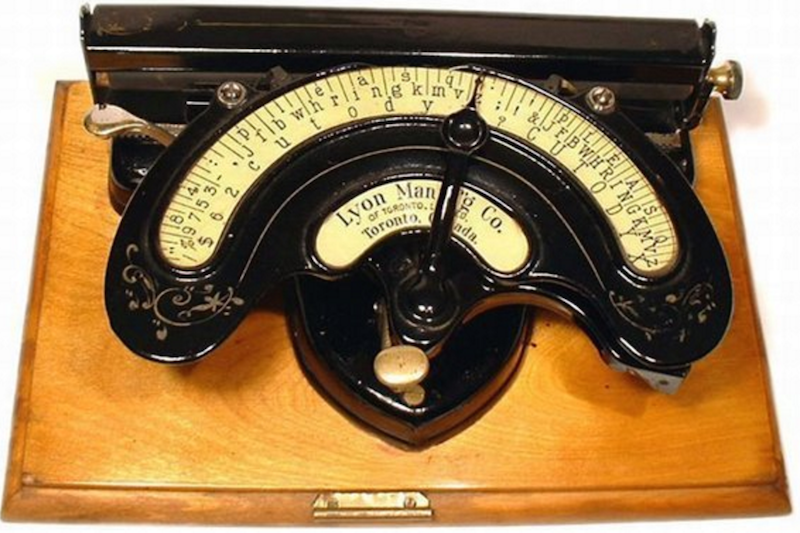
The typewriter created by Franz Wagner was the typewriter of the “new generation”. In 1890, he received a patent for such a device in which the letter levers were placed horizontally, and when typing the text you could see the font, there was no breakage when pressed. John Underwood bought the right to release such machines. So there were famous devices Underwood.
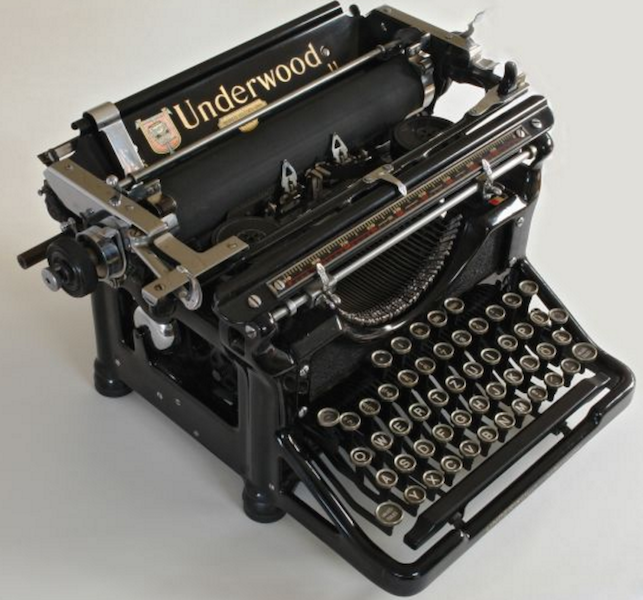
In 1958, Olivetti bought Underwood with its factories in the USA, Canada, Germany and England. Olivetti has become the world leader in the production of portable machines. For its benefit, nearly 25 thousand people worked, 16 factories and branches around the world.
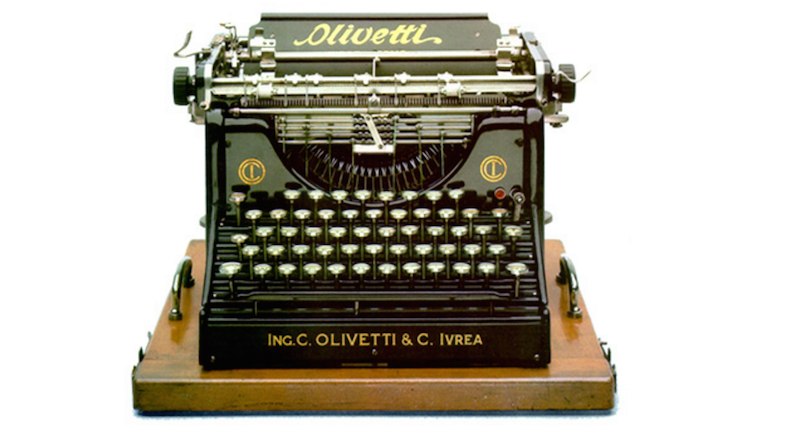
All these cars deserve attention, but I would like to recall ours, with the Russian layout)
Oddly enough, the Russian keyboard layout was invented in America at the end of the XIX century. Initially, these were cars with the YIUKEN layout, after Yatuka, which was familiar to us, disappeared from the Russian language “Yat” and “I”.
After the release of typewriters to the world market in 1882, the Remington machine came to St. Petersburg. The command of the imperial army appreciated this invention, since using copy paper could simultaneously print several copies of the document, secret correspondence was greatly facilitated.
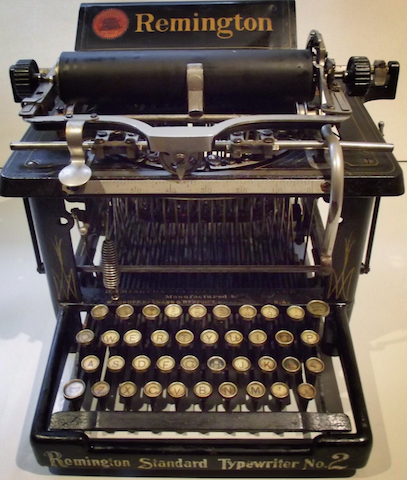
So already at the beginning of the 20th century about 25 thousand typewriters were imported into Russia annually. The championship in the market belonged to the company Remington, the only foreign manufacturer that produced cars with Russian type. Such a typewriter was sold in Russia for 325 rubles. A few years later, Underwood at the expense of price and speed pressed Remington. In 1913, the demand for typewriters increased to 40 thousand copies per year.
The German car company Mercedes also engaged in the production of typewriters. Mercedes Prima from 20 years of the twentieth century was made specifically for Russia. The German company Wanderer-Werke also engaged in the production of Continental typewriters with the letters of the Russian alphabet.
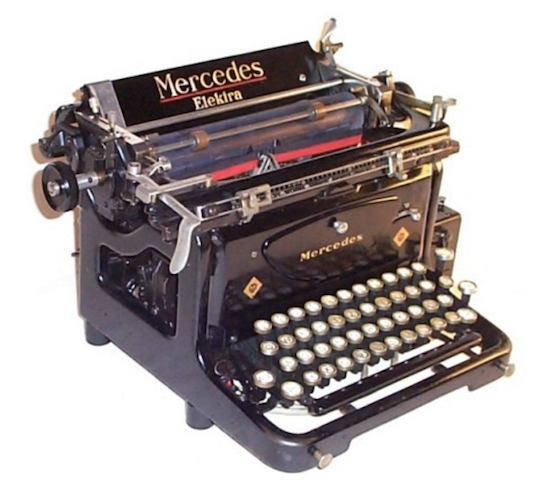
In 1928, in Kazan, under the name Yanalif (the abbreviation of two Tatar words merged with each other, meaning “new alphabet”), the first Soviet machine was produced, such a machine was produced in just 10 years.

Bashkiria is considered one of the first domestic printing machines. She gathered in the city of Ufa manually former street children, united in the labor communes. Pre-war samples of this machine are considered the most reliable and easiest to restore.
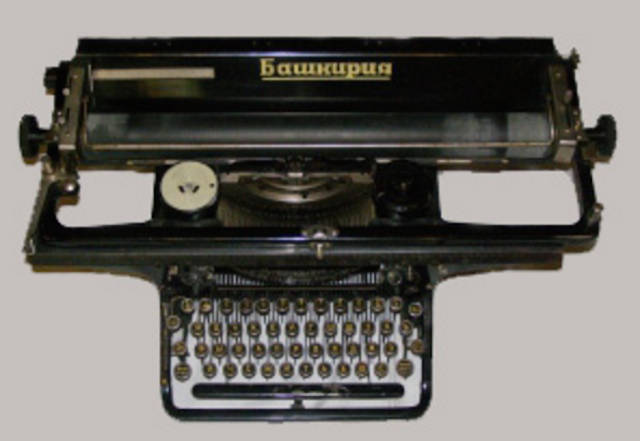
This machine was large, with a wide carriage under an A3 format paper sheet, long-stroke and heavy in print, the range of movement of the lettered levers was impressive. Because of the wire connecting the keyboards and lettered levers printing on such a device was not very clear. The base and the base of the carriage carriage were made of cast iron, the levers and teeth of the carriage were of steel, and the keys were hollow cylinders with symbols covered with glass. Those who worked on such a device remember it not with a kindly word, their hands got tired, some called it “the horror of Bashkiria”. It was a clerical typewriter, which at that time was not available to “private traders” (writers, journalists, scholars). Office machines were with long levers, large print and a wide carriage, capable of printing on sheets of paper A3. True portables were sold, they were even smaller in size and accessible to the general public.
The serial production of domestic typewriters began as early as 1940, and it was the typewriter model Leningrad.
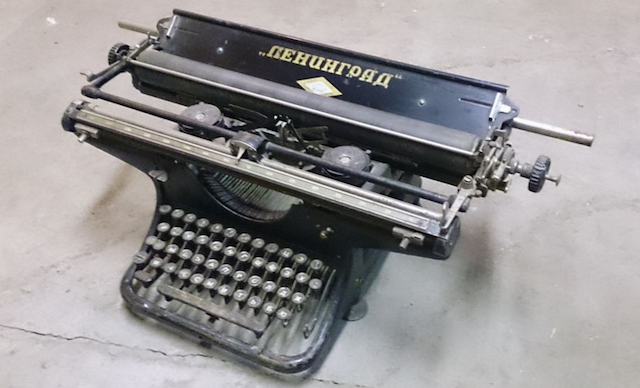
The first electric typewriter was the 1935 American Electromatic Edition. Then followed Erika. The mechanical typewriter differed from the electric one in that the blow was made using an electric drive, this allowed you to press the keys with less effort, you could type a number of identical symbols while holding the key.
Among the portable typewriters that were used in the USSR, the most popular was the German Erika machine. The machine for retyping books, it could make up to 7 copies at once using thin tissue paper. Erika was produced in Dresden from 1950 to 1980 and was exported to the USSR. She weighed 4 pounds.
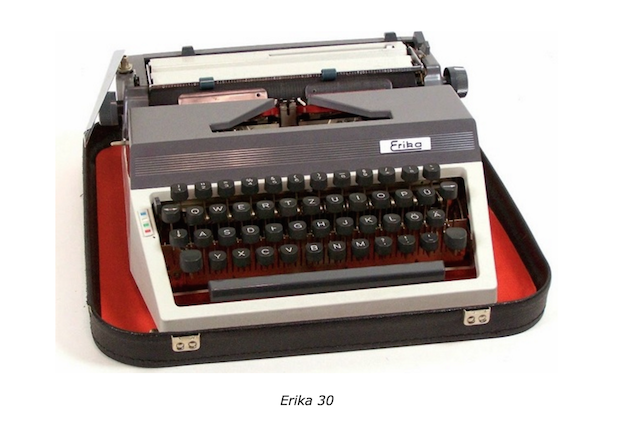
Erika was a compact typewriter, in a suitcase of leatherette and differed impeccably precise work, and in general was considered one of the lowest noise typewriters.
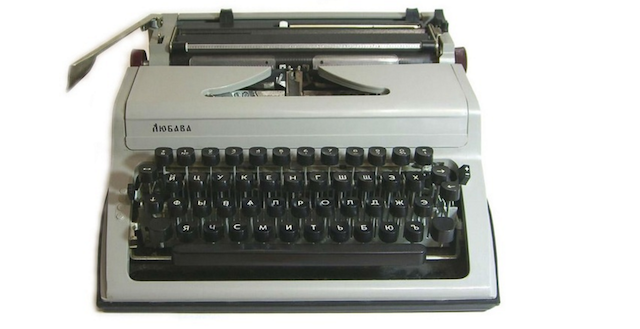
Lyubava was produced at the Ryazan plant of calculating analytical machines, was made under the German license for the German machine Erika. It was compact and convenient, stored in a case.
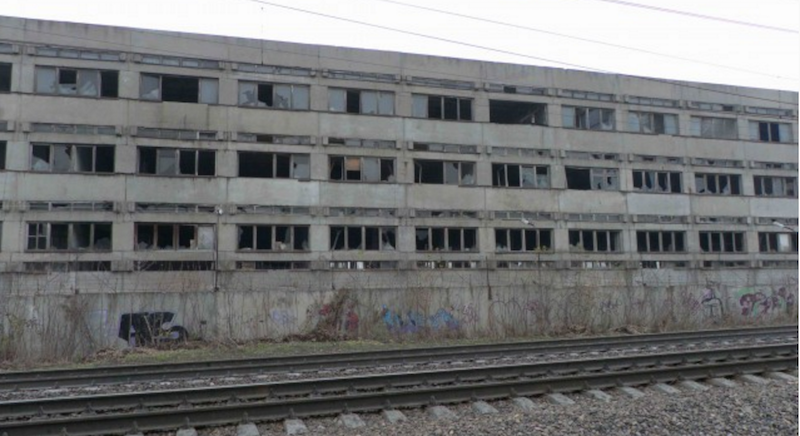
Ryazan plant calculating machines in our days
Portable Moscow was in use by people of creative professions, weighed such a device at least five kilograms. It was a square-shaped suitcase with rounded corners of ordinary plywood, which was covered with black or brown leatherette.
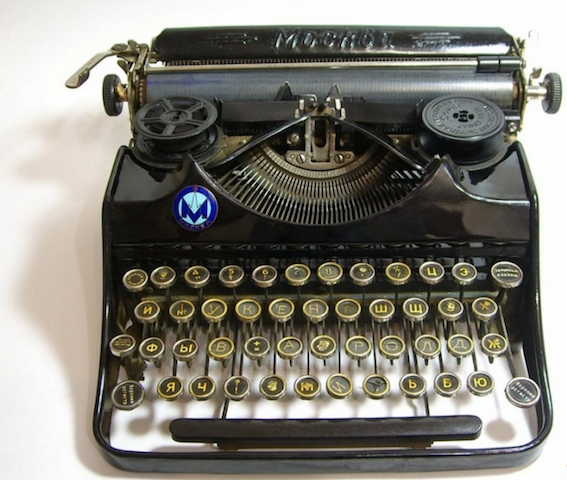
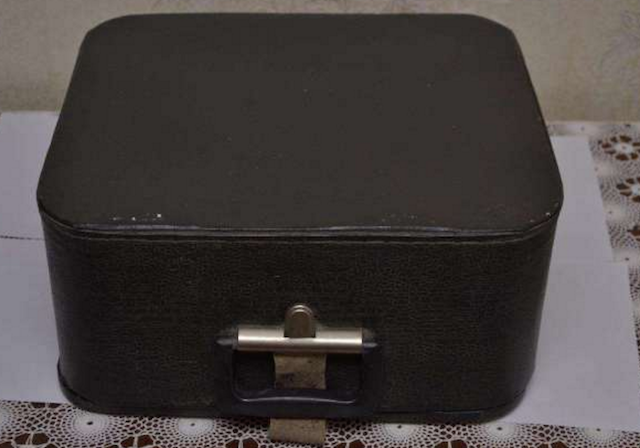
The Yatran typewriter was produced from 1975 to 1995 in Kirovograd at the Pishmash plant; it was the main typewriter manufacturer in the USSR.
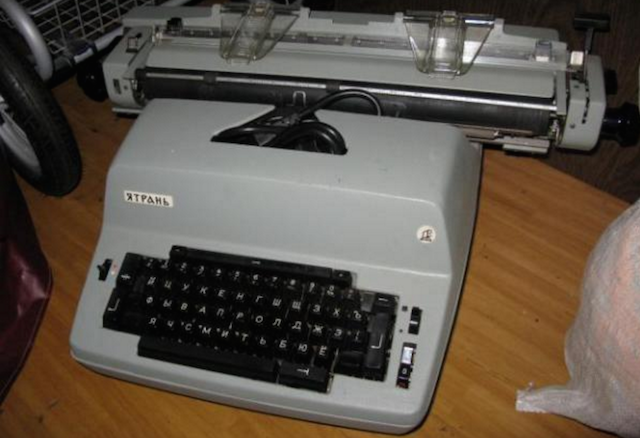
Named it in honor of the river Yatran.

Olympia
The German Olympia machine was a prototype of Yatrani, Olympia’s production technology was bought by the USSR, a re-branded Soviet-style. The product was relatively small in size and contained about three thousand parts, and this is neither more nor less than 25 kg. It should be noted that the parts from which Yatran was assembled had 5-6 degrees of freedom, for the manufacture of which required adjacent equipment of high accuracy. Everything was bought, brought and installed at the plant in Kirovograd, at the best of times, the production volume was 140 thousand cars per year. However, as time went on, German machines were wearing out, product quality was plummeting. According to Lyudmila Shubina, the former deputy director of Pishmash, “mass production eventually led to the fact that it was no longer a typewriter, but a printed“ misfortune ”(on one of these machines the craftsmen of a sharp word wrote“ Yadryan ”). The design of the device did not change all twenty years of its assembly. And if in the early eighties there was no opportunity to update the conveyor and purchase new technologies, by the end of the 80 there was no point in this.
The keyboard of the typewriter, one can say, is almost no different from a computer, the letters are true only in Cyrillic, if suddenly there was (and it arose) the need for Latin letters, it was necessary to enter it manually. It was necessary to change the tape often, since the paint on it did not hold for a long time, the paper made its way to the holes. At the end of the eighties, Soviet-made synthetic ribbons came to the rescue, the service life of such ribbons was longer than they dried up. It was necessary to be able to change the tape itself, so that it took the correct position and did not jump out in the process of work.
Today, typewriters are almost completely superseded by computers. “I remember that in order to print a diploma, dissertation or manuscript, one had to search either by advertisements pasted on poles, or among acquaintances of a person who is proficient in typewriting and is the happy owner of a typewriter. These lucky ones, by the way, earned good money. And I also remember how the characteristic crash of the machines came from the machinery office in the institutions and especially in the editorial offices. It was immediately clear - people are working. Now we can only see the muffled sound of the keys on the computer. And even that is not clear - a person sticks in or plays toys ”.
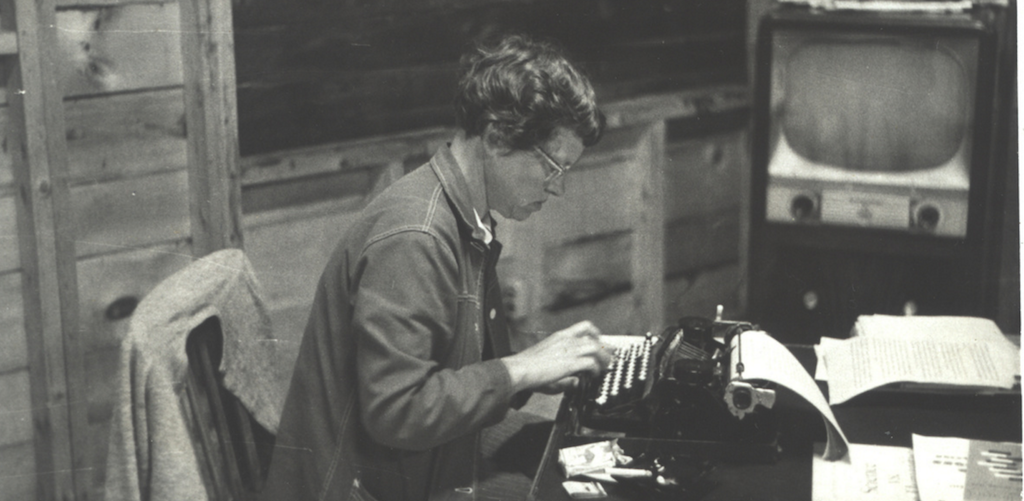
Apparently, soon I will also have to use one of these printing machines, to buy one of the copies (or to find in the bins of the motherland) is much simpler and cheaper than replacing Mac (perhaps the next article will be devoted to the topic “how did you manage to pull the Macbook out of the world it will cost me (not just nerves). "

“It would be better if I washed the whole street with a fanto, it’s cheaper,” I complained to a friend who, without hesitation, advised while Mas was in repair, to work on Yatran'ka, it will be a bit heavy! What is Yatranka, I learned, using the Google search engine) - it turned out to be a typewriter.
')
At the same time, he told his “regrettable” story from his childhood from the Yatran typewriter.
Sometime something similar happened to me. Having finished my lessons, I decided to write a letter to my beloved grandfather, so much to surprise. There was no computer then, but the space under the table was not empty, the Yatran electric typewriter was stored there. While papa, straining all the muscles of his arms and back, was tearing her off the floor, as if it was not a machine, but a ship that sank under the table, I went to the kitchen to get Pepsi. "The younger generation chooses Pepsi," said the slogan of the late nineties. Feeling inspired and taking a bottle with me, I sat down at my desk. The engine was buzzing, the carriage was running, and thoughts were cheerfully minted on paper. But the trouble! Inadvertently knocked over the bottle, sweet dark drops and splashed inside - richly "moistened" the bosom of the iron body. I automatically pulled the plug out of the net. What now? But after five minutes the fear receded and I decided to turn it on again. Contrary to expectations, no spark, no short circuit followed. On the contrary! After printing a couple of lines, I clearly felt that the device began to work faster and better, as if it was not pepsi-cola, but oil, which lubricated the rubbing dry mechanism in time. Five minutes later, the letter was ready, and the machine sank again, in the legs, half a meter below the "sea level" of the table.

About the Yatran typewriter a little later, because it became interesting to learn in more detail about what preceded the usual typing on a computer keyboard. If earlier a typewriter was a means of typing characters, expressing and replicating thoughts, then a computer is already a device for integrating a person into the world information space. Everyone knows that the keyboard layout and the principle of its operation is that small gene pool that the modern “electronic friend of a man” inherited from a typewriter. But which of our parents could believe that having only the keys with letters on you can call yourself a taxi, order goods at home or publish an article on the Internet? Today, the reality is that life without pressing soft keys, or without driving your finger on the sensor, is not only impossible, but sometimes dangerous to health. In 2009, an interesting material was published in a Finnish newspaper, tips on picking mushrooms for beginning scouts. Lovers of protein of plant origin, in all seriousness recommended to take a laptop into the forest and check their mushrooms with pictures on a special site. Can you imagine a mushroom picker with a laptop and a basket of chanterelles?
Just a couple of decades ago, no institution, organization, office could not do without such, at the moment, rare miracle of technology like a typewriter. Immediately I recall at least a couple of Soviet films, in the frame of which typewriters of one brand or another made up on the table. By the way - a prestigious thing, which over the years has replaced the keyboard and monitor (well, and a couple of programs like Word).
Since childhood (aunt worked as a secretary in the village council) I remember these knocking sounds, a short ringing made by the machine during the return movement of the carriage. Oh, and if you also managed to “work” with such a technique, write a couple of letters not by hand - there were enough impressions for a few days.
Typing the text now (here now this article) doesn’t cause any special problems, since you can easily remove / replace the letter word, and there is a whole text, you just need to press the desired key. On the other hand, it was with typewriters, the letter bladed for help (whitewashed a little later) was not correctly knocked out, and this was at best, and you just had to take a sheet of paper and throw it away, and the work started anew. The wise decision was to initially write the text by hand with a pen, and then type it on a typewriter.
The year 1873 is considered the beginning of the production of the first typewriters, although the idea of its creation arose a couple of centuries earlier. In England, even issued a royal order, in which there was a decree to create a device for printing texts, in 1714 Queen Anne granted a patent to Henry Mill for such a “thing”. Since there is no information about this device, the first operating machine that was presented to the world by an Italian named Terry Pellegrino was a writing apparatus made for the blind girlfriend of Countess Caroline Fantoni de Fivizono in 1808. Due to this, she was able to communicate with her friends and relatives through correspondence.

In 1886, George Anderson patented a tape for a typewriter. It remains an interesting fact that the mechanism for typing was invented 52 times: such models were reminiscent of a wedding cake, and a gaming machine, one model was 2.5 meters high. The keyboard for such typewriters, similar to a piano one, appeared only in the 30s of the XIX century. Letters on such a keyboard with the help of rollers were covered with ink. Charles Turber patented a typewriter for the blind in the distant 1843, and he also invented a lever transmission of the movement of letters.
Create an ideal and convenient apparatus for writing - this is what captures the minds of the inventors of the time. The Americans Christopher Scholes and Samuel Sule in 1863 invented a device for numbering pages in counting books, and this principle was laid when creating a typewriter. The first such patented machine had two rows of keys with numbers and alphabetical arrangement of letters from A to Z, the letters were capitalized and there were no numbers 1 and 0, they were replaced by the letters “I” and “O”. It was difficult to call such a device convenient, because with a quick successive pressing of the letters located nearby, the hammers with the letters got stuck, the work was suspended and it was necessary to rake the jam by hand. After analyzing the most common letters in the English alphabet, they were located on the keyboard as far as possible from each other, which made it possible to avoid such “sticking”. So the QWERTY keyboard was invented.

early typewriter type
For five years, the inventors improved their patented Type-Writer and signed an agreement to release 10,000 typewriters with Remington and Sons
The first serial typewriter was the Remington No. 1 typewriter, which saw the world on July 1 in 1874.

Remington # 1


later models Remington # 5 and 6
It even produced furniture for such a typewriter:


What typewriters were not created. Each such typewriter resembled a real masterpiece.

Special purpose printing presses were developed and produced: verbatim, bookkeeping, writing formulas, for the blind and many others.


Typewriters without a keyboard, so-called index typewriters, were developed. Such machines cost less, a letter on the index was selected with one hand, and a lever for printing a letter on paper was pressed with the other hand.

The typewriter created by Franz Wagner was the typewriter of the “new generation”. In 1890, he received a patent for such a device in which the letter levers were placed horizontally, and when typing the text you could see the font, there was no breakage when pressed. John Underwood bought the right to release such machines. So there were famous devices Underwood.

In 1958, Olivetti bought Underwood with its factories in the USA, Canada, Germany and England. Olivetti has become the world leader in the production of portable machines. For its benefit, nearly 25 thousand people worked, 16 factories and branches around the world.

All these cars deserve attention, but I would like to recall ours, with the Russian layout)
Typewriter with Cyrillic layout
Oddly enough, the Russian keyboard layout was invented in America at the end of the XIX century. Initially, these were cars with the YIUKEN layout, after Yatuka, which was familiar to us, disappeared from the Russian language “Yat” and “I”.
After the release of typewriters to the world market in 1882, the Remington machine came to St. Petersburg. The command of the imperial army appreciated this invention, since using copy paper could simultaneously print several copies of the document, secret correspondence was greatly facilitated.
Sami. officers and adjutants of directorates and staffs will personally use the machine to make papers and reports in secret correspondence when the contents of the paper, except for yy. staff officers should not be known to anyone else.

So already at the beginning of the 20th century about 25 thousand typewriters were imported into Russia annually. The championship in the market belonged to the company Remington, the only foreign manufacturer that produced cars with Russian type. Such a typewriter was sold in Russia for 325 rubles. A few years later, Underwood at the expense of price and speed pressed Remington. In 1913, the demand for typewriters increased to 40 thousand copies per year.
The German car company Mercedes also engaged in the production of typewriters. Mercedes Prima from 20 years of the twentieth century was made specifically for Russia. The German company Wanderer-Werke also engaged in the production of Continental typewriters with the letters of the Russian alphabet.

In 1928, in Kazan, under the name Yanalif (the abbreviation of two Tatar words merged with each other, meaning “new alphabet”), the first Soviet machine was produced, such a machine was produced in just 10 years.

Bashkiria is considered one of the first domestic printing machines. She gathered in the city of Ufa manually former street children, united in the labor communes. Pre-war samples of this machine are considered the most reliable and easiest to restore.

This machine was large, with a wide carriage under an A3 format paper sheet, long-stroke and heavy in print, the range of movement of the lettered levers was impressive. Because of the wire connecting the keyboards and lettered levers printing on such a device was not very clear. The base and the base of the carriage carriage were made of cast iron, the levers and teeth of the carriage were of steel, and the keys were hollow cylinders with symbols covered with glass. Those who worked on such a device remember it not with a kindly word, their hands got tired, some called it “the horror of Bashkiria”. It was a clerical typewriter, which at that time was not available to “private traders” (writers, journalists, scholars). Office machines were with long levers, large print and a wide carriage, capable of printing on sheets of paper A3. True portables were sold, they were even smaller in size and accessible to the general public.
The serial production of domestic typewriters began as early as 1940, and it was the typewriter model Leningrad.

The first electric typewriter was the 1935 American Electromatic Edition. Then followed Erika. The mechanical typewriter differed from the electric one in that the blow was made using an electric drive, this allowed you to press the keys with less effort, you could type a number of identical symbols while holding the key.
Among the portable typewriters that were used in the USSR, the most popular was the German Erika machine. The machine for retyping books, it could make up to 7 copies at once using thin tissue paper. Erika was produced in Dresden from 1950 to 1980 and was exported to the USSR. She weighed 4 pounds.

Erika was a compact typewriter, in a suitcase of leatherette and differed impeccably precise work, and in general was considered one of the lowest noise typewriters.

Lyubava was produced at the Ryazan plant of calculating analytical machines, was made under the German license for the German machine Erika. It was compact and convenient, stored in a case.

Ryazan plant calculating machines in our days
Portable Moscow was in use by people of creative professions, weighed such a device at least five kilograms. It was a square-shaped suitcase with rounded corners of ordinary plywood, which was covered with black or brown leatherette.


The Yatran typewriter was produced from 1975 to 1995 in Kirovograd at the Pishmash plant; it was the main typewriter manufacturer in the USSR.

Named it in honor of the river Yatran.

Olympia
The German Olympia machine was a prototype of Yatrani, Olympia’s production technology was bought by the USSR, a re-branded Soviet-style. The product was relatively small in size and contained about three thousand parts, and this is neither more nor less than 25 kg. It should be noted that the parts from which Yatran was assembled had 5-6 degrees of freedom, for the manufacture of which required adjacent equipment of high accuracy. Everything was bought, brought and installed at the plant in Kirovograd, at the best of times, the production volume was 140 thousand cars per year. However, as time went on, German machines were wearing out, product quality was plummeting. According to Lyudmila Shubina, the former deputy director of Pishmash, “mass production eventually led to the fact that it was no longer a typewriter, but a printed“ misfortune ”(on one of these machines the craftsmen of a sharp word wrote“ Yadryan ”). The design of the device did not change all twenty years of its assembly. And if in the early eighties there was no opportunity to update the conveyor and purchase new technologies, by the end of the 80 there was no point in this.
The keyboard of the typewriter, one can say, is almost no different from a computer, the letters are true only in Cyrillic, if suddenly there was (and it arose) the need for Latin letters, it was necessary to enter it manually. It was necessary to change the tape often, since the paint on it did not hold for a long time, the paper made its way to the holes. At the end of the eighties, Soviet-made synthetic ribbons came to the rescue, the service life of such ribbons was longer than they dried up. It was necessary to be able to change the tape itself, so that it took the correct position and did not jump out in the process of work.
Today, typewriters are almost completely superseded by computers. “I remember that in order to print a diploma, dissertation or manuscript, one had to search either by advertisements pasted on poles, or among acquaintances of a person who is proficient in typewriting and is the happy owner of a typewriter. These lucky ones, by the way, earned good money. And I also remember how the characteristic crash of the machines came from the machinery office in the institutions and especially in the editorial offices. It was immediately clear - people are working. Now we can only see the muffled sound of the keys on the computer. And even that is not clear - a person sticks in or plays toys ”.

Apparently, soon I will also have to use one of these printing machines, to buy one of the copies (or to find in the bins of the motherland) is much simpler and cheaper than replacing Mac (perhaps the next article will be devoted to the topic “how did you manage to pull the Macbook out of the world it will cost me (not just nerves). "
Source: https://habr.com/ru/post/391987/
All Articles